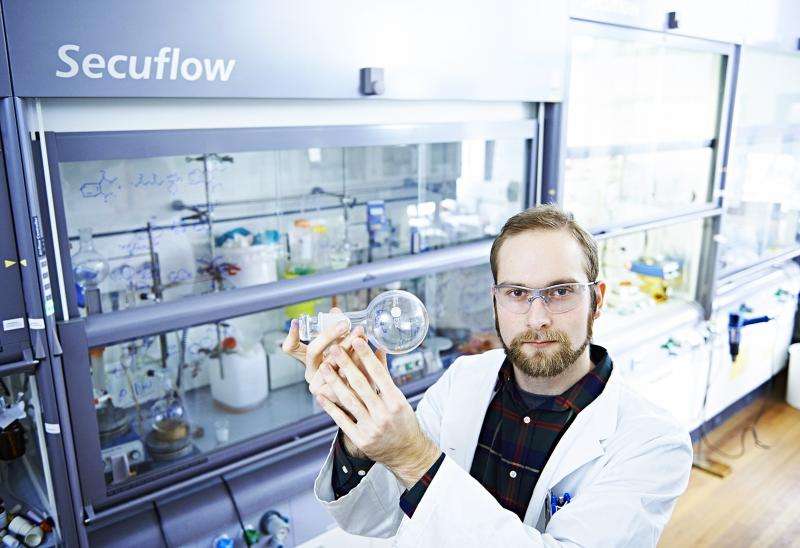Copemhagen chemistry student Anders Bo Skov is getting set to save sunshine for a rainy day
The sun is a huge source of energy. In just one hour, Earth is hit by so much sunshine that humankind could cover its energy needs for an entire year, if only we knew how to harvest and save it. But storing sunshine is not trivial. Now a student at The department of chemistry at the University of Copenhagen has made a breakthrough that may prove pivotal for technologies to capture the energy of the sun and save it for a rainy day.
Together with his supervisor, Mogens Brøndsted Nielsen, Anders Bo Skov is publishing the paper "Towards Solar Energy Storage in the Photochromic Dihydroazulene-Vinylheptafulvene System" in the journal Chemistry – A European Journal.
Professor Brøndsted is in charge of the Center for Exploitation of Solar Energy at the University of Copenhagen. Here, his team is attempting to develop molecules capable of harvesting substantial amounts of solar energy and storing it for significant amounts of time, releasing it on demand. A year of research had them butting their heads against what looked like an irksome law of nature. As the capacity of the molecules to hold energy seemed to improve, the capacity to store it over time dropped, and vice versa.
The group is working with molecules known as the dihydroazulene-vinylheptafulvene system. Put very simply, this stores energy by changing shape, but every time the Brøndsted group managed to design improved molecules, the molecules lost some of their ability to hold their energy storage configuration, says professor Brøndsted.
"Regardless of what we did to prevent it, the molecules would change their shape back and release the stored energy after just an hour or two. Anders' achievement was that he managed to double the energy density in a molecule that can hold its shape for a hundred years. Our only problem now is how we get it to release the energy again. The molecule does not seem to want to change its shape back again," says Mogens Brøndsted.
During his Bachelor studies, Anders Bo Skov had four months to improve Brøndsted's unstable molecule for his bachelor project. And he completed it in the nick of time. Chemistry is a lot like baking. No bread is likely to come out of the oven if, for example, the flour disappears while the dough is proving. Using that analogy, Skov's "bread" persisted in disappearing between his very hands. The molecules he was working with were that unstable.
"My chemical 'recipe' demanded four synthesis steps in order to work. The first three were a piece of cake. I had them working in just a month. Getting the last step in order took me three months," says Skov.
Regardless of the method, when you store energy, there is a theoretical limit to the energy density. And then there is reality. In theory, a kilogram of the right molecules could store a megajoule of energy if they were perfectly designed. With that amount of energy you can heat three liters of water from room temperature to boiling.
A kilo of Skov's molecules can boil only 75 centiliters but it does that in just three minutes. This means that his molecules could bring to the boil 15 liters of water per hour. Skov and his supervisor are convinced that this is just the beginning.
"What Anders has achieved is an important breakthrough. Admittedly, we do not have a good method to release the energy on demand and we should increase the energy density further still. But now we know which path to take in order to succeed," says a visibly enthusiastic professor Mogens Brøndsted. Skov too is excited: Mostly because his molecules are sustainable on more levels than just the obvious one. Not only do they harvest sustainable solar energy, they are also completely non-toxic, he relates.
"When it comes to storing solar power, our biggest competition comes from lithium ion batteries. Lithium is a poisonous metal. My molecule releases neither CO2, nor any other chemical compounds while working. It is 'sunlight in-power out.' And when the molecule wears out one day, it degrades to a colorant which is also found in chamomile flowers," explains the student.
Despite all the frustrations, Skov has become so excited about his bachelor project that he has brought it with him into his master's programme. Normally, master students will start the programme by taking courses for a year before turning to the research for their theses. Skov, on the other hand, just stayed in the lab after his bachelor project. He is affiliated with the Center for Exploitation of Solar Energy in order to pursue his ideas for tweaking the sun-catcher molecule. Now he wants it to release the energy on demand. And the 25 year-old student is brimming with ideas for the construction of such a compliant molecule.
More information: "Towards Solar Energy Storage in the Photochromic Dihydroazulene-Vinylheptafulvene System," Chemistry – A European Journal, DOI: 10.1002/chem.201500100
Journal information: Chemistry – A European Journal
Provided by University of Copenhagen





















